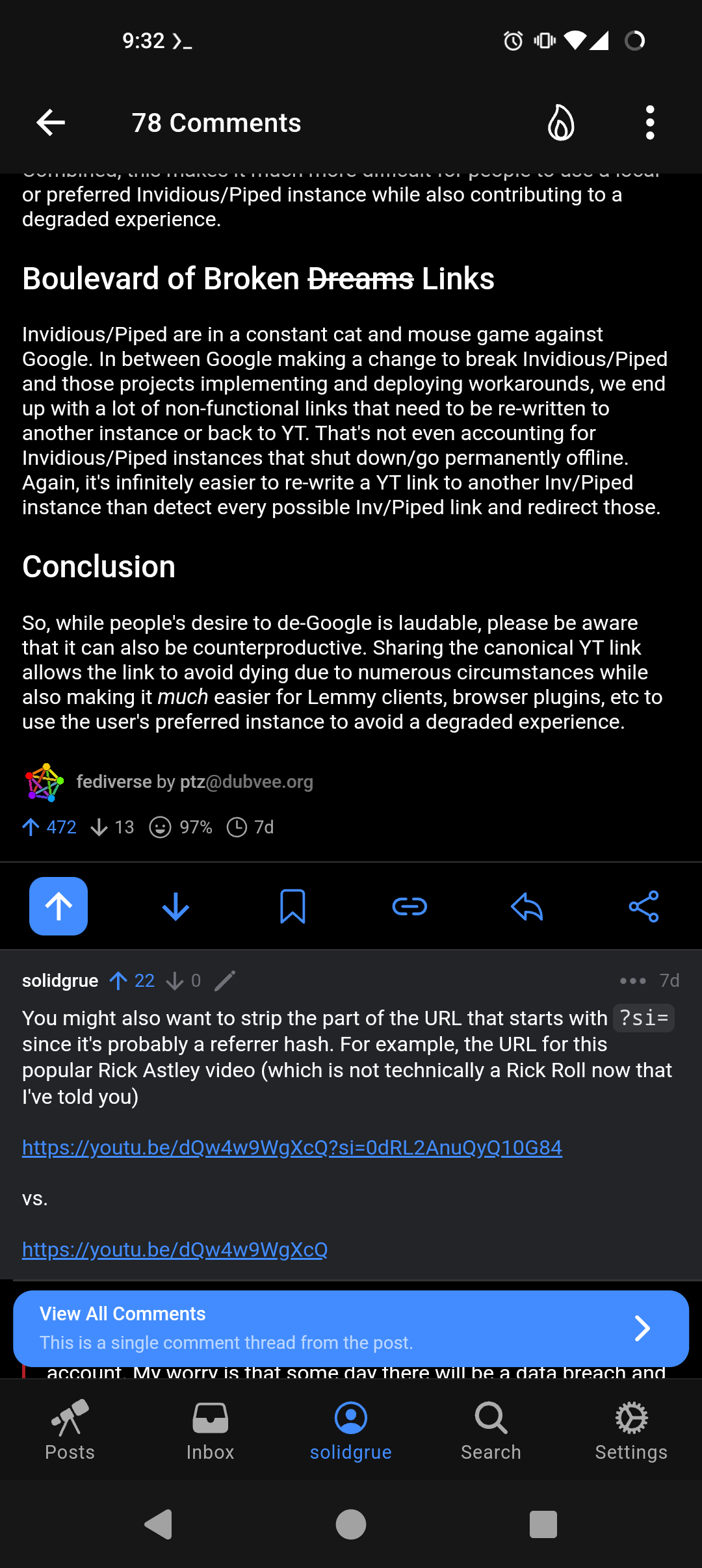Oracle Cloud will also delete your shit for the price of admission.
Caveat emptor, hey?
I’m just this guy, you know?
Oracle Cloud will also delete your shit for the price of admission.
Caveat emptor, hey?
So, uh…
Digital Ocean Is pretty inexpensive at US$7 monthly for 1 vCPU/1GB RAM with 1TB transfer. Decent platform. US-based, alas.
(2025 September, for the archives)


I have some logic around notifications and a few actions. My spouse and I both grew up in houses with heat, but no AC, so I’ve programmed HA to send notifications to our phones if the setpoint on our Ecobee thermostat is warmer than the outside temperature in Cooling mode, and cooler than the outside temp in Heating mode. Outdoor temps are a blend of three weather service feed “feels like” observations and two outdoor temperate/humidity sensors.
The outdoor sensors are a ZigBee sensor, and some area sensors I snoop a few times an hour with an RTL-SDR radio single via MQTT bus. I have a helper that blends the weather service and local obs to compare with the thermostat. It bothers us every 2 hours to open some windows.
We both also have a bad habit of not closing the back door all the way, so the Assistant bugs us if a door or window is open for more than 10 minutes and the outdoor temperature is below the heating setpoint, or above the cooling setpoint. It turns off the HVAC a few minutes later if the condition persists and sends a snarky notification about not being made of enough money to fix climate change. However, it will turn the heat back on to 60F if the house falls below 58F and send notifications every hour til the condition is addressed.
Otherwise the ecobee does a fair job adjusting itself to maintain a desired inside temp on its own.


You’ve solved it by now but this Jellyfin doc article was helpful for me, beginning with the section Naming.
https://jellyfin.org/docs/general/server/media/movies/
There at similar guides for TV Shows, Music, Books and other mixed media.
There are also guides for “stacking” multi-segment media titles, for example Lord of the Rings movies which come on several discs.
Jellyfin can be a bit opinionated about detecting bad metadata. The override tags in the media data filename or folder name can help clean that up. In fact, I’ve started hard-coding those [tmdbid=…] tags in my encoding workflow because I’m just so damned tired of fighting with the metadata feature.
Hope it works form you,.too.


Yeah, I know.
Aurora is immutable, I fucked up. Oops.
Edit: unsubscribed. My life will be better.


I read this post using the Alexandrite front end on my laptop browser, then I opened Voyager app on my phone and it shows the post as already having been read.


I don’t use my computers for modern gaming. Like OP, I prefer tabletop games, though I do speed run crossword puzzles and play some PixelDungeon on my phone when I have spare time. I also built a Retropie, and play some old Atari and PS2 roms on a bored Sunday. My stuff can run Civ IV, which is probably the last title I bought.
My main systems are for work, or for supporting self-hosted services including local infrastructure, home lab stuff, email, blogs, home automation, media servers, etc, etc. Lately I’ve been getting into SDR projects using RPi or old laptops.
So, uh… Yeah. Fun stuff, but not so much gaming.


You might also want to strip the part of the URL that starts with ?si= since it’s probably a referrer hash. For example, the URL for this popular Rick Astley video (which is not technically a Rick Roll now that I’ve told you)
vs.
(Edit: for the record…

)
Wikipedia, kernel sources and some LLM models


USA. 4 lines with unlimited calls, text, and data. International calling and roaming throughout US, Canada & Mexico. Metered by the mjnute/megabyte for international (off-continent) travel. All in, $200 monthly.
(TMO, magenta plan which is now defunct)


Man, I got stuff to do. Lol.


I mean…
Steam? Maybe? I dunno, I don’t game but the Steam kids seem to prefer Arch. I’m sure they have their reasons.
Practically? Probably nothing terribly significant.


As someone on semaglutide therapy, I can share that a large calorie deficit hits you in the wills to live. At some point even just eating feels like a stop at the gas station to fuel up, and it hardly matters whether it’s 87 or 95 octane. Hell, rancid fry oil would even work. At some point, you stop caring whether you eat because it feels like another chore.
Eventually your metabolism syncs up again with your energy demand and you start getting interested in food, except you’re way more selective about how you’re (edit: spending) acquiring those calories. I almost can’t abide by junk food, fast food, or breaded fried crap anymore. But neither do I want salad or vegetables because they’re “fluffy.” Too much volume, not enough calories. I want about 6 or 10 forks full of food, and then that’s it. And it’d best taste good, or I can’t be bothered. Restaurants easily stop looking like a good deal.
Anyway that’s a digest of my diary for the last 22 months. Do with the info as you will.
Thanks! I hate this. 🖤


Seconded! My 5T was the best phone I’ve ever carried. I carry the OP11 5G these days and I’ve been really happy with it, but overall I prefer the size and weight of the 5T.
Never going in with a Sicilian when death is on the line?
Termux (on F-droid) is a userland environment that runs on top of your Android device’s kernel. It has Debian/Ubuntu-like package management system that pulls from repos maintained by the termux team. If the package is available for aarch64, its probably available in the termux repos. Its not so much of an app as it is an alternate userland that runs on top of the same kernel, but can interact with Android a couple of different ways.
The main Termux app gets you a basic command line environment with the usual tools included in a headless Linux install. From there you can select your preferred repos, do package updates, installs, etc, just like on a desktop or laptop. You could even install a desktop environment and use RDP to access it.
Then there are some companion apps that are useful:
So you could install the syncthing package in Termux and (after setting up Termux access for your internal storage) configure it to sync folders from your phone to wherever syncthing syncs. You’d set up a start script under Termux:boot to launch it when your phone starts, or Tasker to start/stop the service on your home WiFi.
And I genuinely hope it stays that way for years more to come. Cheers.